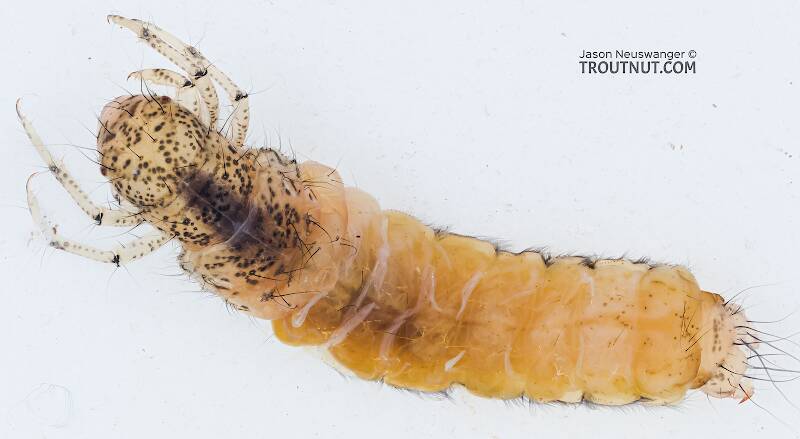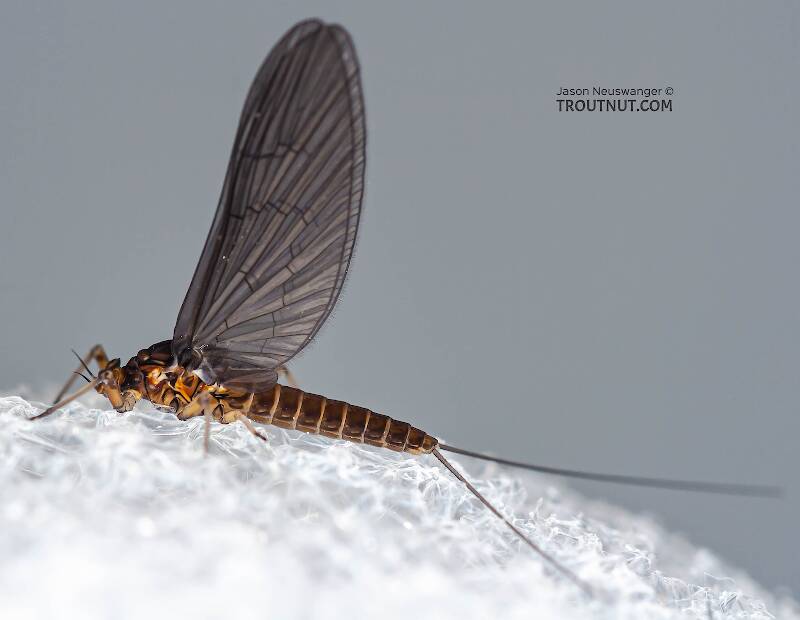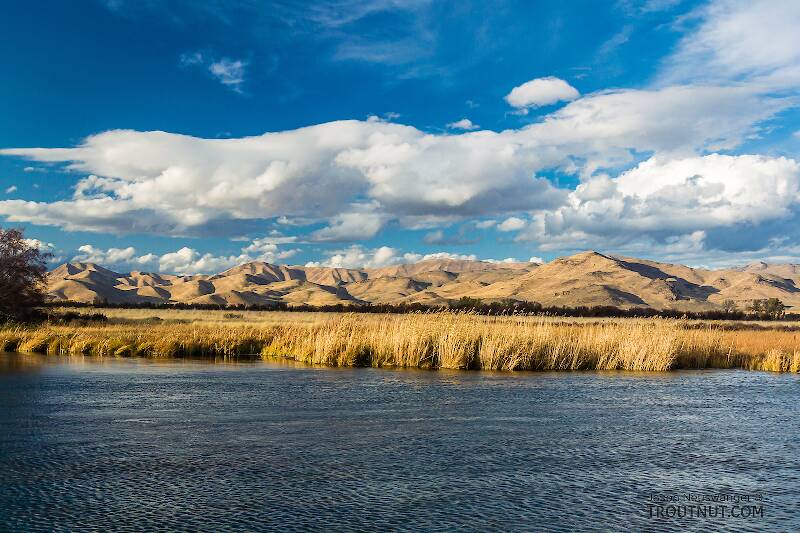
Salmonflies
Pteronarcys californica
The giant Salmonflies of the Western mountains are legendary for their proclivity to elicit consistent dry-fly action and ferocious strikes.
Featured on the forum

This is a striking caddis larva with an interesting color pattern on the head. Here are some characteristics I was able to see under the microscope, but could not easily expose for a picture:
- The prosternal horn is present.
- The mandible is clearly toothed, not formed into a uniform scraper blade.
- The seems to be only 2 major setae on the ventral edge of the hind femur.
- Chloride epithelia seem to be absent from the dorsal side of any abdominal segments.
Based on these characteristics and the ones more easily visible from the pictures, this seems to be Grammotaulius. The key's description of the case is spot-on: "Case cylindrical, made of longitudinally arranged sedge or similar leaves," as is the description of the markings on the head, "Dorsum of head light brownish yellow with numerous discrete, small, dark spots." The spot pattern on the head is a very good match to figure 19.312 of Merritt R.W., Cummins, K.W., and Berg, M.B. (2019). The species ID is based on Grammotaulius betteni being the only species of this genus known in Washington state.
- The prosternal horn is present.
- The mandible is clearly toothed, not formed into a uniform scraper blade.
- The seems to be only 2 major setae on the ventral edge of the hind femur.
- Chloride epithelia seem to be absent from the dorsal side of any abdominal segments.
Based on these characteristics and the ones more easily visible from the pictures, this seems to be Grammotaulius. The key's description of the case is spot-on: "Case cylindrical, made of longitudinally arranged sedge or similar leaves," as is the description of the markings on the head, "Dorsum of head light brownish yellow with numerous discrete, small, dark spots." The spot pattern on the head is a very good match to figure 19.312 of Merritt R.W., Cummins, K.W., and Berg, M.B. (2019). The species ID is based on Grammotaulius betteni being the only species of this genus known in Washington state.

Troutnut is a project started in 2003 by salmonid ecologist Jason "Troutnut" Neuswanger to help anglers and
fly tyers unabashedly embrace the entomological side of the sport. Learn more about Troutnut or
support the project for an enhanced experience here.

This little early-season dun molted into this spinner after I photographed her.
CaseyP on Oct 16, 2009October 16th, 2009, 7:28 am EDT
read no further if stories of personal revelation are not your thing...
at last i have actually seen these little wonders hatching on a not-very-nice day (overcast and 46 degrees) on a very nice creek. gee, they are neat! the cold kept them on the water for quite a while and they did indeed look just like little sailboats. the small eddies and riffles seemed not to bother them at all, and made the whole assembly look like a tiny square dance. now i understand what all the fuss is about.
the best/worst part was letting my store-bought fly drift among them. it was the right size, but the wing was too short and the hackle should have been dun, not grizzley. stream-side tying was out of the question 'cause my fingers were numb. i did get one fish, but he might have been after the real one next the imitation...
so, back to the bench and those awful tiny hooks. lots of baseball to tie to these days...;-)
at last i have actually seen these little wonders hatching on a not-very-nice day (overcast and 46 degrees) on a very nice creek. gee, they are neat! the cold kept them on the water for quite a while and they did indeed look just like little sailboats. the small eddies and riffles seemed not to bother them at all, and made the whole assembly look like a tiny square dance. now i understand what all the fuss is about.
the best/worst part was letting my store-bought fly drift among them. it was the right size, but the wing was too short and the hackle should have been dun, not grizzley. stream-side tying was out of the question 'cause my fingers were numb. i did get one fish, but he might have been after the real one next the imitation...
so, back to the bench and those awful tiny hooks. lots of baseball to tie to these days...;-)
"You can observe a lot by watching." Yogi Berra
Martinlf on Oct 16, 2009October 16th, 2009, 8:36 am EDT
Casey, the olive emerger I sent in the fly swap often works when these little guys are out, especially in the spring when the bugs are a bit bigger. The barbless gamakatsu hooks I use for the spring emerger may not go down small enough for some of the fall varieties, but a small scud hook will work. Also, a Tiemco 921 hook in the smaller sizes is good sometimes for comparaduns and other dun patterns for these bugs. I also use it when I tie Gonzo's shucking emerger, but don't tell him! It is a 2X short hook, and it has a very wide gap for effective hooking. It's also a bit heavy, and helps the fly sit low in the film. Have fun; olives are just the best!
"He spread them a yard and a half. 'And every one that got away is this big.'"
--Fred Chappell
--Fred Chappell
CaseyP on Oct 17, 2009October 17th, 2009, 11:09 am EDT
thanks, Louis! when i went to look at the bug pictures, there was a recipe from you, and i can add the hook info to that. a heavier hook seems to be a good idea in these teeny sizes since the heft of the material grows as the hook size shrinks, it seems to me. the heavier hook would make it float right. the gamakatsu hooks are pretty fine--though they make a wonderful little klinkhamer.
thanks for the help!
thanks for the help!
"You can observe a lot by watching." Yogi Berra
RedQuill27 on Nov 15, 2009November 15th, 2009, 2:30 am EST
Olives are the best and most plentiful hatch that I have ever fished. I almost always have the best luck with a Quill Bodied parachute. The trick with this hatch is just like the trico hatch, don't flock shoot. You have to pick a fish a find out the pattern in which he is rising.
Tight Lines!
Tight Lines!
Fishing is like sex, when its good its great, and when its bad its still pretty good.
Quick Reply
Related Discussions
Topic
Replies
Last Reply
Re: I need your help to get some specimens of Caecidotea (Freshwater isopods).
In General Discussion by Leonardo
In General Discussion by Leonardo
4
Jun 1, 2016
by Crepuscular
by Crepuscular
3
Apr 11, 2018
by Martinlf
by Martinlf
1
Jan 7, 2009
by Phishheaduj
by Phishheaduj



